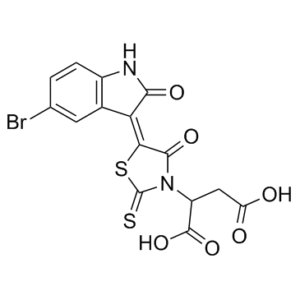CID5721353 (also known as BCL6 Inhibitor and 79-6) is a novel and potent inhibitor of BCL6 (B-Cell Lymphoma 6) with an IC50 value of 212 μM (equivalent to a Ki of 147 μM). In diffuse large B cell lymphoma (DLBCL), the BCL6 transcriptional repressor is the most frequently involved oncogene. In order to find low-molecular-weight substances that bind to the corepressor binding groove of the BCL6 BTB domain, computer-aided drug design and functional assays were combined. One such substance was found to bind the crucial site within the BTB groove and disrupt BCL6/corepressor complexes both in vitro and in vivo. CID5721353 has the ability to kill BCL6-positive DLBCL cell lines by inducing the expression of BCL6 target genes. CID5721353 was nontoxic and effectively suppressed DLBCL tumors in vivo in xenotransplantation studies. CID5721353 also killed primary DLBCLs from human patients.
Physicochemical Properties
| Molecular Formula | C15H9BRN2O6S2 | |
| Molecular Weight | 457.275760412216 | |
| Exact Mass | 457.269 | |
| Elemental Analysis | C, 39.40; H, 1.98; Br, 17.47; N, 6.13; O, 20.99; S, 14.02 | |
| CAS # | 301356-95-6 | |
| Related CAS # |
|
|
| PubChem CID | 3800971 | |
| Appearance | Light brown to brown solid powder | |
| LogP | 1.1 | |
| Hydrogen Bond Donor Count | 3 | |
| Hydrogen Bond Acceptor Count | 8 | |
| Rotatable Bond Count | 5 | |
| Heavy Atom Count | 26 | |
| Complexity | 930 | |
| Defined Atom Stereocenter Count | 0 | |
| InChi Key | UMZWNADQRDCKII-UHFFFAOYSA-N | |
| InChi Code | InChI=1S/C15H9BrN2O6S2/c16-5-1-2-7-6(3-5)10(12(21)17-7)11-13(22)18(15(25)26-11)8(14(23)24)4-9(19)20/h1-3,8,22H,4H2,(H,19,20)(H,23,24) | |
| Chemical Name | 2-[5-(5-bromo-2-oxoindol-3-yl)-4-hydroxy-2-sulfanylidene-1,3-thiazol-3-yl]butanedioic acid | |
| Synonyms |
|
|
| HS Tariff Code | 2934.99.9001 | |
| Storage |
Powder-20°C 3 years 4°C 2 years In solvent -80°C 6 months -20°C 1 month |
|
| Shipping Condition | Room temperature (This product is stable at ambient temperature for a few days during ordinary shipping and time spent in Customs) |
Biological Activity
| Targets | BCL6 (IC50 = 212 μM); BCL6 (Ki = 147 μM) |
| ln Vitro | Small molecular BCL6 inhibitor 79-6 is a cell-permeable oxindole compound that specifically inhibits BCL6's transcriptional repression activity without affecting BCL6 protein levels[2]. When 79-6 binds to an aromatic pocket in the lateral groove of the BTB domain, it causes the disruption of BCL6 transcriptional complexes, the reactivation of BCL6 target genes, and the selective killing of BCL6-dependent DLBCL cells[1]. Through its RD2 domain, BCL6 can also interact with MTA3 and repress terminal differentiation. Through its DBD domain, it attracts CtBP and inhibits the expression of itself. In MCF-7 and MDA231 cells, 79-6 inhibits their capacity to invade and form colonies. E-cadherin'smRNAexpression was improved in MCF-7 and MDA231 cells following BCL6 inhibition with 79-6. BCL6's roles in the positive control of EMT, invasion, and transcriptional repression of E-cadherin in breast cancer cells are reversed by 79-6[2]. |
| ln Vivo | The size of established BCL6-dependent DLBCL xenografts was reduced by 65-70% upon administration of 50 mg/kg/day 79-6 to SCID mice, but BCL6-independent DLBCLs were unaffected[1]. In vivo, therapeutic targeting of BCL6 with the small molecule 79-6 is a successful antilymphoma tactic[3]. |
| Cell Assay | Cells from MCF-7 and MDA231 were plated on the upper chamber of the filters and treated for 48 hours with 79-6 (200 mol/L) or vehicle (DMSO), respectively. We counted the cells that had spread to the filter's underside (magnification, ×200). |
| Animal Protocol | Mice: Six to eight-week old male SCID mice are subcutaneously injected in the left flank with low-passage 107 human OCI-Ly7 cells. Mice are IP injected with 50 mg/kg of CID5721353 in DMSO (n=8) or DMSO (control, n=2) when tumors reach 1500 mm3. Following injection, blood and tumors are harvested at various times (30 min, 1 h, 1.5 h, 3 h, 6 h, 12 h, and 24 h)[1]. |
| References |
[1]. Clin Cancer Res . 2017 Feb 15;23(4):885-893. [2]. Cancer Lett . 2015 Sep 1;365(2):190-200. [3]. Biochem Biophys Res Commun. 2017 Jan 8;482(2):310-316. |
Solubility Data
| Solubility (In Vitro) |
|
|||
| Solubility (In Vivo) |
Solubility in Formulation 1: ≥ 2.5 mg/mL (5.47 mM) (saturation unknown) in 10% DMSO + 40% PEG300 + 5% Tween80 + 45% Saline (add these co-solvents sequentially from left to right, and one by one), clear solution. For example, if 1 mL of working solution is to be prepared, you can add 100 μL of 25.0 mg/mL clear DMSO stock solution to 400 μL PEG300 and mix evenly; then add 50 μL Tween-80 to the above solution and mix evenly; then add 450 μL normal saline to adjust the volume to 1 mL. Preparation of saline: Dissolve 0.9 g of sodium chloride in 100 mL ddH₂ O to obtain a clear solution. Solubility in Formulation 2: ≥ 2.5 mg/mL (5.47 mM) (saturation unknown) in 10% DMSO + 90% (20% SBE-β-CD in Saline) (add these co-solvents sequentially from left to right, and one by one), clear solution. For example, if 1 mL of working solution is to be prepared, you can add 100 μL of 25.0 mg/mL clear DMSO stock solution to 900 μL of 20% SBE-β-CD physiological saline solution and mix evenly. Preparation of 20% SBE-β-CD in Saline (4°C,1 week): Dissolve 2 g SBE-β-CD in 10 mL saline to obtain a clear solution. (Please use freshly prepared in vivo formulations for optimal results.) |
| Preparing Stock Solutions | 1 mg | 5 mg | 10 mg | |
| 1 mM | 2.1868 mL | 10.9342 mL | 21.8684 mL | |
| 5 mM | 0.4374 mL | 2.1868 mL | 4.3737 mL | |
| 10 mM | 0.2187 mL | 1.0934 mL | 2.1868 mL |
